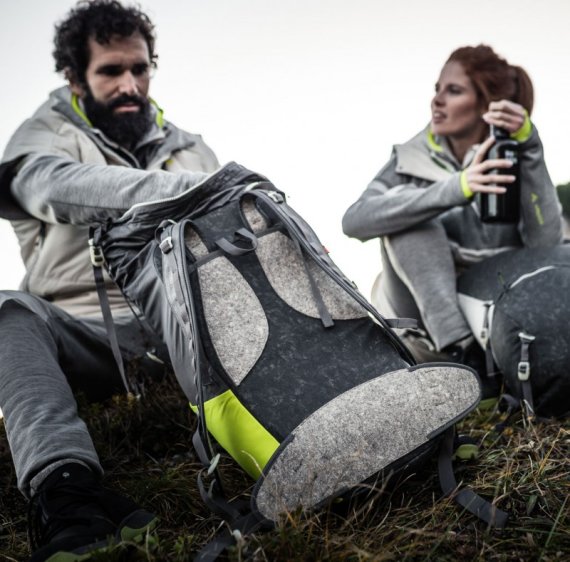
Microplastics are solid and insoluble synthetic polymers - plastics - that are smaller than five millimeters. They are barely visible to the naked eye and have been found in lakes, rivers and oceans, even in sediments at the bottom of bodies of water, even in the deep sea and in remote marine regions such as the Arctic. According to Greenpeace, there is hardly a body of water left in the world that is not "contaminated with plastic.
The problem: The tiny plastic particles can no longer be removed from the environment. They are insoluble in water and difficult to degrade. Complete chemical degradation can take several hundred years. And of course, they are eaten by animals and other organisms and thus enter the human food chain.
Exactly where microplastics come from and how they end up in the water has not yet been clarified. However, various international studies have come to the conclusion that textiles based on synthetic fibers play a significant role in this. Polyester fleece materials are particularly affected. During production and household washing of synthetic fiber textiles, microplastic particles are released - so the observation goes - that cannot be completely retained by wastewater treatment plants.
"It is assumed," explains Nicole Espey of the German Sporting Goods Industry Association (BSI), "that about 95 percent of microfibers are intercepted in wastewater treatment plants in this country, but about 5 percent pass through." In other countries, including the producing countries, the percentage can be much higher.
BSI participated in the three-year multidisciplinary research project "TextileMission", which started in September 2017 and was funded by the German Federal Ministry of Education and Research (BMBF) with around 1.7 million euros. The catalog of measures was broad. Espey: "It has to be found out how high the amount of microfibers actually is that is released during washing, alternatives have to be found for textile polyester, and better retention techniques in wastewater treatment plants or washing machines have to be found."
In addition to BSI, the companies Adidas, Polartec, Vaude, Henkel, Miele, Niederrhein University of Applied Sciences, TU Dresden and WWF Germany participated in the research project. The European Outdoor Group (EOG) also worked with biov8tion and the University of Leeds to combat microfiber pollution as part of the ongoing Outdoor Industry Microfibre Consortium project.
TextileMission presented its findings in February 2021. It is estimated that between 2.5 and 59 kg of microplastics are released into the environment through wastewater treatment plants for every one hundred thousand inhabitants. To reduce this amount, the stakeholders of the research project present two approaches: One is the use of textile technology processes to produce lower-emission textiles. The second approach is to rely increasingly on natural fibers in order to offer sustainable textiles in the long term that are both produced in an environmentally friendly manner and do not represent an additional burden during washing and disposal.
Various sports brands are already reacting and presenting the first, optimized products. For example, Vaude, together with the Italian fabric producer Pontetorto, presented the first biodegradable fleece "Biopile" at the beginning of November 2017. A special construction of the fabric prevents microfibers from being secreted during washing and wearing. If fibers do get released, the inner, roughened side of the fabric is not made of polyester, but 100 percent Tencel wood cellulose fiber from Lenzing, which is also biodegradable in seawater.
Tatonka is also presenting the first Biopile products from Pontetorto for the upcoming spring/summer season 2019. Fewer seams here are also intended to help reduce cut-off scraps that can end up as waste in bodies of water. Polartec, the world's largest fleece producer and a partner in the research project, also presented its first projects in fall 2018.

Adidas has been working with the New York environmental lobby organization Parley for the Oceans since 2015 and since then has been launching Adidas Parley shoe series with growing success, some of which are made from plastic waste from the ocean. The products are flanked by extensive marketing activities, such as the "Run for the Oceans," which took place in May 2022.
One of the first pragmatic product innovations on the subject of microplastics came from the Berlin start-up Guppy Friend. The consumer is supposed to pack all the textiles that easily lose fibers into the Guppy Friend wash bag. On the one hand, the bag is supposed to release fewer fibers from the fabrics, but above all, the dense weave is supposed to prevent them from getting into the wastewater.
The problem, however, is that the wash bag places the responsibility on the consumer, who must dispose of the microplastics carefully to prevent them from ending up in the water again.

- ISPO awards
- Mountain sports
- Bike
- Design
- Retail
- Fitness
- Health
- ISPO Job Market
- ISPO Munich
- ISPO Shanghai
- Running
- Brands
- Sustainability
- Olympia
- OutDoor
- Promotion
- Sports Business
- ISPO Textrends
- Triathlon
- Water sports
- Winter sports
- eSports
- SportsTech
- OutDoor by ISPO
- Heroes
- Transformation
- Sport Fashion
- Urban Culture
- Challenges of a CEO
- Trade fairs
- Sports
- Find the Balance
- Product reviews
- Newsletter Exclusive Area
- Magazine






